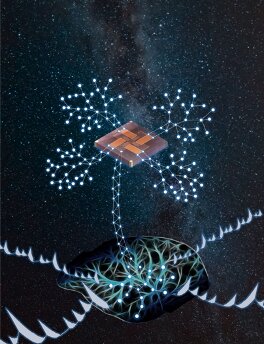
Neuromorphic computing entails building architectures inspired by elements of the human brain, such as neural organization and synapses. These architectures have proved to be highly promising and advantageous for a number of applications, as they can have both memory and learning functions.
Most current neuromorphic architectures artificially recreate the plasticity (i.e., ability to be easily shaped over time) of synapses, which are junctions between nerve cells that enable the propagation of impulses across brain regions. Another potentially valuable source of inspiration for neuromorphic computing approaches, however, is the plasticity of the neuronal membrane, the protective barrier that preserves the functioning of neurons.
With this in mind, researchers at TU Dresden and Hemholtz Center have recently designed a neurotransistor that emulates the intrinsic plasticity of the neuronal membrane. The new neurotransistor, presented in a paper published in Nature Electronics, was fabricated by coating a silicon nanowire with an ion-doped sol-gel silicate film.
“As a group with primary expertise in biological and chemical electronic sensors, we tried to find a suitable system that replicated the properties of the neuronal membrane using the principles of biosensors,” Larysa Baraban, one of the researchers who carried out the study, told TechXplore.
The neurotransistor designed by Eunhye Baek, Baraban and their colleagues exploits the properties of electronic potentiometric biosensors based on silicon nanowire transistors. This class of sensors can convert the charges of an ion or molecule into electric current. The researchers combined a field effect transistor that electronically senses ionic charges with a sol-gel film, which enables the redistribution of ionic charges.
“We fabricated silicon nanowire transistors using a CMOS process such as electron beam and UV lithography on an eight-inch silicon-on-insulator (SOI) wafer,” Gianaurelio Cuniberti, another researcher involved in the study, told TechXplore. “We then coated the nanowire devices with ion-doped silicate film, which is synthesized by the sol-gel process using silicate-based precursors and metal ions.”
The new neurotransistor presented by Baek, Baraban, Cuniberti and their colleagues can act as a short-term memory, as the sol-gel film restricts the movement of ions inside it and maintains certain ionic states for a short period of time. Due to this unique quality, the sol-gel film allows the neurotransistor to generate unique nonlinear (i.e., sigmoid) output dynamics, which are governed by the history of the input signal.
The device developed by the researchers emulates the functionality and intrinsic plasticity of a neuron cell. In fact, in neurons, a membrane potential induces a sigmoidal change in the ionic current. This nonlinear dynamic property also gives it advanced learning capabilities, making it ideal for machine-learning applications, for instance, learning how to perform well in pattern-classification tasks.
“The most meaningful achievement of our study is our neurotransistor network’s dynamic learning ability, attained using the plasticity of a neuron,” Eunhye Baek, one of the lead researchers for the study, told TechXplore. “Many neuromorphic devices (mainly memristors), hardly control the output dynamics due to their stochasticity like a random current threshold.”
The design strategy employed by the researchers allows their neurotransistor to use the quantified amount of doped-ions in its cell to attain stable output dynamics. As the goal of the recent study by Baraban, Cuniberti, Baek and their colleagues was to mimic the nonlinear computation of neurons, their neurotransistor can be used to perform device-level classification, without the need for post-data treatment. This enables more powerful neuromorphic computations with lower energy consumption, as other existing pattern classification models that run on neuromorphic devices require additional software calculations.
“Ultimately, we showed that one can start from a conventional field effect transistor, or even a whole chip, and turn it into a neurotransistor (or neurochip) with completely new functionalities, via its selective modification using sol-gel film,” Baraban said.
This work confirms the considerable potential of neuromorphic electronic components for achieving both memory and learning functions in a single device. By emulating the plasticity of neural membranes, their new strategy for designing neurotransistors could enable the creation of new electronics with advanced learning capabilities.
“We are now pursuing further brain-inspired computing research at Tsinghua University using hybrid memristors to develop artificial visual-sensory neurons like the retina,” Baek said. “Before the incoming signal reaches the brain, memory and learning already occur in sensory neurons to preprocess the signal. The dynamic learning principle behind our neurotransistor will be applied to process the time-varying light signal.” https://techxplore.com/news/2020-06-silicon-nanowire-transistors-memory-functions.html







Recent Comments